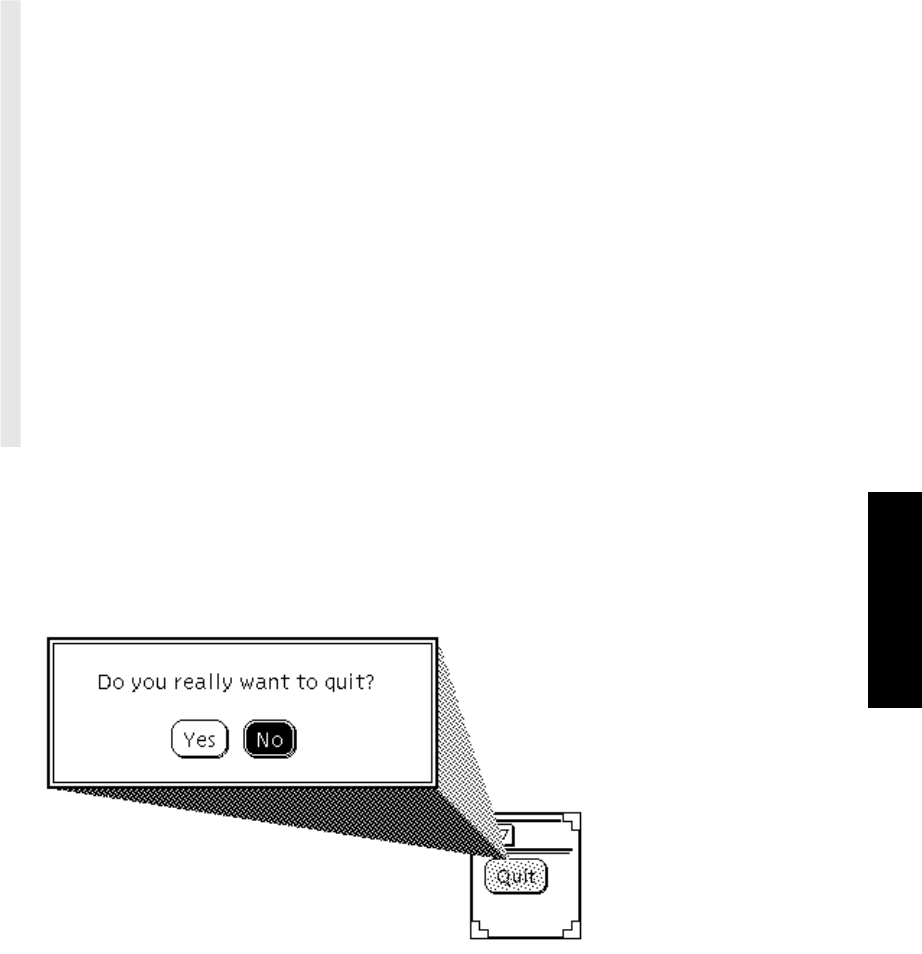
B
The notice_prompt Function
This section describes the XView compatibility procedure notice_prompt(). If you
need to create a new notice, use the NOTICE package described in Chapter 12, Notices. The
information in this chapter describes the old notice interface that is supported for compatibil-
ity with older XView versions.
A notice is a pop-up window that notifies the user of a problem or asks a question that
requires an immediate response. The notice grabs the entire screen so no other windows or
applications can receive input until the user responds to the notice.
Notices are implemented using the FULLSCREEN package to grab the keyboard and pointer
events from the server. (The FULLSCREEN package is described in Chapter 15, Nonvisual
Objects.) The notice window, which owns the fullscreen object, is a nonrectangular transient
X window with the X-window attribute override_redirect* set. When the notice is
created, the notice window is immediately displayed. When the user responds to one of the
available choices, the notice session ends.
B.1 Creating and Displaying Notices
To use the NOTICE package in applications, the header file <xview/notice.h> must be
included. Notices are special XView objects because they are not created via
xv_create(). Also, they cannot be modified using xv_set(). Notices are created using
the special procedure notice_prompt():
int
notice_prompt(owner, event, attrs)
Xv_Window owner;
Event *event;
attributes ...
When creating a notice, the owner must be a valid XView object that has a window associ-
ated with it. This can be a panel or a frame, but it is typically the window that causes the
notice to be created. If the user tries to type in a read-only text subwindow, a notice might
appear from that window informing the user of the error. The event might be NULL if you
are not using NOTICE_TRIGGER (see Section 12.1.2, “Notice Triggers”).
*override_redirect tells the window manager to not provide window decorations.
The notice_prompt
Function
The notice_prompt Function 655
Because the notice window is not a part of any other XView package and it does not allow
window-specific attributes, you cannot use any generic, common or window attributes to
configure the notice window; you can only use NOTICE_* attributes.
Notice windows are explicitly specified by OPEN LOOK and cannot be modified. If you wish
to create a notice-type interface that is not OPEN LOOK compliant (which is not recom-
mended), you need to learn more about the fullscreen object described in Chapter 15, Non-
visual Objects.
Your application has control over the messages that are displayed in the notice window as
well as the choices available to the user as responses. notice_prompt() creates a win-
dow, grabs the server, waits for the user to make a selection on one of the available button
choices, then destroys the window. You never have a handle to the notice object itself—only
the resulting choice made by the user. The result is the return value of the
notice_prompt() function.
A very simple case of a notice prompt is demonstrated in Example B-1.
Example B-1. The simple_notice.c program
/*
* simple_notice.c -- Demonstrate the use of notices.
*/
#include <xview/xview.h>
#include <xview/panel.h>
#include <xview/notice.h>
main(argc,argv)
int argc;
char *argv[ ];
{
Frame frame;
Panel panel;
Xv_opaque my_notify_proc();
/*
* Initialize XView, create a frame, a panel and one panel button.
*/
xv_init(XV_INIT_ARGS, argc, argv, NULL);
frame = (Frame)xv_create(XV_NULL, FRAME, NULL);
panel = (Panel)xv_create(frame, PANEL, NULL);
xv_create(panel, PANEL_BUTTON,
PANEL_LABEL_STRING, "Quit",
PANEL_NOTIFY_PROC, my_notify_proc,
NULL);
/* make sure everything looks good */
window_fit(panel);
window_fit(frame);
/* start window event processing */
xv_main_loop(frame);
}
/*
656 XView Programming Manual

Example B-1. The simple_notice.c program (continued)
* my_notify_proc() -- called when the user selects the Quit button.
* The notice appears as a result of notice_prompt(). Here
* the user must chooses YES or NO to confirm or deny quitting.
*/
Xv_opaque
my_notify_proc(item, event)
Panel_item item;
Event *event;
{
int result;
result = notice_prompt(panel, NULL,
NOTICE_FOCUS_XY, event_x(event), event_y(event),
NOTICE_MESSAGE_STRINGS, "Do you really want to quit?", NULL,
NOTICE_BUTTON_YES, "Yes",
NOTICE_BUTTON_NO, "No",
NULL);
if (result == NOTICE_YES)
exit(0);
}
The program simple_notice.c contains a panel with a Quit button. When the user selects the
Quit button, a notice pops up to prompt the user for confirmation. What the user sees is
shown in Figure B-1. If the user presses “Yes,” the program exits.
Figure B-1. Output of simple_notice.c while the notice is up
The position from which the notice shadow emanates is described by the attribute
NOTICE_FOCUS_XY. This value defaults to the current mouse position when the application
calls notice_prompt(). As shown in simple_notice.c, the point from which the notice
shadow emanates appears to be the same position as the location where the panel button was
The notice_prompt
Function
The notice_prompt Function 657
selected. Due to possible delays with the X server, by the time the notice_prompt()
routine gets called, the location of the mouse may have moved from the place where the
panel button was selected. To be sure that the notice prompt appears to emanate from the
original mouse-down location, we use the coordinates of the mouse position from the event
structure. The values for NOTICE_FOCUS_XY are relative to the origin of the window passed
as the first parameter to notice_prompt().
B.1.1 Response Choices and Values
Two responses are normally present whenever a notice appears: “Yes” and “No.” These are
defined for convenience in <xview/notice.h>:
#define NOTICE_YES 1
#define NOTICE_NO 0
These are the return values that notice_prompt() might return that correspond directly
to the attributes NOTICE_BUTTON_YES and NOTICE_BUTTON_NO. As shown in
simple_notice.c, these are the only two choices made available to the user.
These two choices are special in another way: they respond to accelerator keys. That is, the
RETURN key can be used instead of selecting the NOTICE_BUTTON_YES button with the
pointer, and the STOP key can be used instead of selecting NOTICE_BUTTON_NO.
Also, when these choices are used, the cursor is immediately bound to the button associated
with NOTICE_BUTTON_YES because this is the default response to the notice. As a hint to the
programmer, it is always desirable to word all questions so the default answer is “Yes.”
It is quite common for the application to have more than one appropriate response to some
kind of notice prompt. Suppose that your application is an editor of some kind. If the user
selects the Quit button and there have been changes to the file that have not been accounted
for, you might wish to inform the user and allow more than one response: quit, updating
changes; quit, ignoring changes; or cancel the quit all together. To implement these new
choices, use the
NOTICE_BUTTON attribute to define the choices available:
result = notice_prompt(panel, NULL,
NOTICE_MESSAGE_STRINGS,
"There have been modifications since your last update",
"Would you like to quit or continue editing?",
NULL,
NOTICE_BUTTON, "Quit, Update changes", 101,
NOTICE_BUTTON, "Quit, Ignore changes", 102,
NOTICE_BUTTON, "Continue Editing", 103,
NULL);
The NOTICE_BUTTON attribute takes two parameters: the button label* and the return value if
that button is selected. In this case, the possible return values for the call to
notice_prompt are 101, 102 and 103 (in addition to possible error return values). The
application should make its decision on how to proceed based on the return value.
*The button can display text only; no graphic images can be displayed.
658 XView Programming Manual

Because the NOTICE_BUTTON attribute is used, there is no default choice and no accelerators
associated with the notice; the user must use the pointer to select one of the available
choices.
B.1.2 Notice Triggers
If you want to assign accelerators to notice buttons, or if you find it necessary to give the user
the choice of using mouse buttons or keyboard events to respond to a notice, you can identify
triggers that cause the notice to return. The value returned in this case is
NOTICE_TRIGGERED, and the event that caused the trigger will be in the Event * passed in
the call to notice_prompt(). When triggers are not used, the Event * can be NULL.
Example B-2 shows how one might use the NOTICE_TRIGGER to get a particular event:
Example B-2. The trigger_notice.c program
/*
* trigger_notice.c -- Demonstrate the use of triggers in notices.
*/
#include <xview/xview.h>
#include <xview/panel.h>
#include <xview/notice.h>
main(argc,argv)
int argc;
char *argv[ ];
{
Frame frame;
Panel panel;
Xv_opaque my_notify_proc();
extern void exit();
/*
* Initialize XView, create a frame, a panel and one panel button.
*/
xv_init(XV_INIT_ARGS, argc, argv, NULL);
frame = (Frame)xv_create(XV_NULL, FRAME, NULL);
panel = (Panel)xv_create(frame, PANEL, NULL);
(void) xv_create(panel, PANEL_BUTTON,
PANEL_LABEL_STRING, "Quit",
PANEL_NOTIFY_PROC, exit,
NULL);
(void) xv_create(panel, PANEL_BUTTON,
PANEL_LABEL_STRING, "Move",
PANEL_NOTIFY_PROC, my_notify_proc,
NULL);
/* make sure everything looks good */
window_fit(panel);
window_fit(frame);
/* start window event processing */
xv_main_loop(frame);
}
The notice_prompt
Function
The notice_prompt Function 659
Get Volume 7A: XView Programming Manual now with the O’Reilly learning platform.
O’Reilly members experience books, live events, courses curated by job role, and more from O’Reilly and nearly 200 top publishers.

